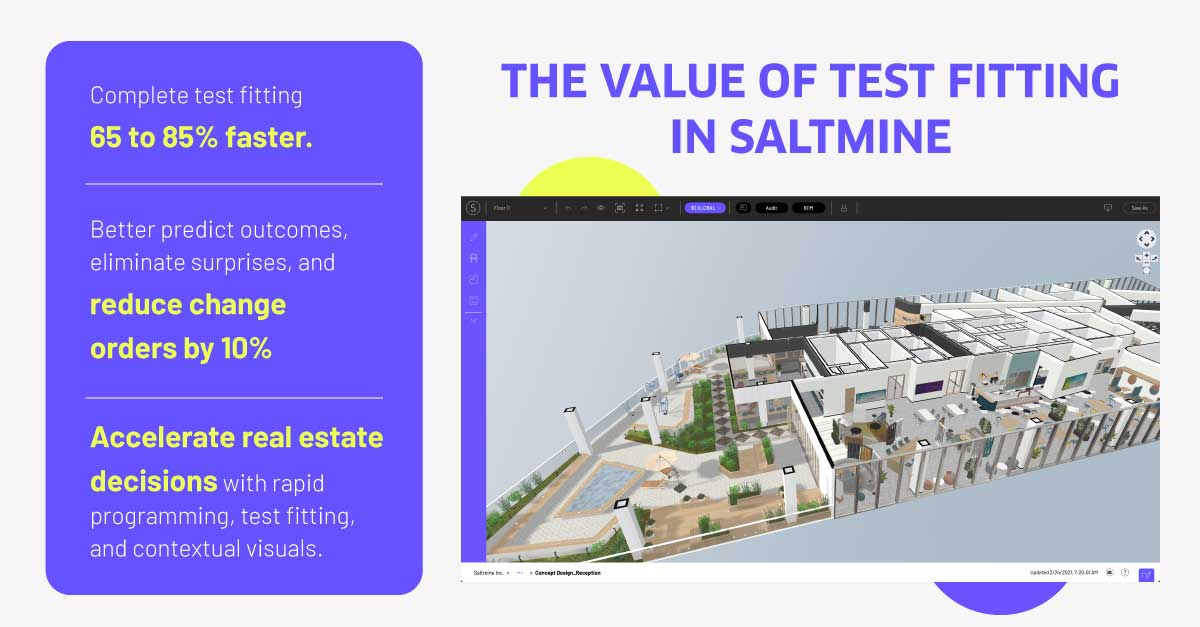The saying goes: measure twice, cut once, not vice versa. This concept is applied heavily in workplace design because nobody wants to make substantial design changes to construction documents. That’s why there is such a necessity for test fitting—a process to assess the project needs in a given space that confirms the number of rooms, areas, and people that can be accommodated.
This blog post will explore the evolving concept of workplace test fitting, the challenges stemming from siloed processes and platforms, and how to create a better test fitting process.
What is the purpose of test fitting?
Test fitting type A: Proof of concept
In the realm of workplace test fitting, it’s essential to distinguish between two primary objectives. The first is what we’ll call “Test Fitting Type A”, where teams conduct a test fit as a proof of concept exercise. The primary goal here isn’t to propose a detailed design but to demonstrate the feasibility of accommodating the program’s requirements on the floor plan. This provides the necessary collateral for project advancement.
During Test Fitting Type A, aesthetics and visualization take a back seat, and the focus shifts to efficient space planning. In Test Fitting Type A, the test fit is often thrown out by the design team in the subsequent phase, and they begin again from scratch.
Test fitting type B: Pre-design and concept development
Now, let’s look at Test Fitting Type B, where the test fitting process is a pre-design step that flows seamlessly into the actual design phase. Unlike Type A, Type B involves individuals with a design background who are keen on more than just proving the program’s feasibility. They are looking at the visual aspects and feel of the workspace, experimenting with different layouts, and even trying to persuade stakeholders with various design schemes.
This approach benefits from creating 3D models to enhance presentations and secure stakeholder approvals.
The 3 challenges of siloed test fitting processes
What are some of the pressing challenges of siloed test fittings, and how can we address them? Read further to find out.
Challenge #1: Limited stakeholder engagement
One major issue is limited stakeholder engagement when considering the challenges of siloed processes and platforms. Conventional test fitting tools like AutoCAD lack the capability to quickly deliver visually sophisticated outputs that resonate with decision-makers who lack architectural expertise.
Challenge #2: Disconnected teams
Another substantial challenge arises from the disconnect within test-fitting teams. It’s common to have planners who conduct initial space analyses but lack design skills for a comprehensive test fit.
This necessitates a handoff between team members, often resulting in delays as they struggle to get their minds and tools to communicate well, producing an inefficient test-fit process.
Challenge #3: Application of design standards
Lastly, applying design standards can introduce significant bottlenecks in the test fitting process. Those unfamiliar with these standards frequently need to reference them, causing delays. What if these design standards were organized for easy and accurate deployment in the same platform you’re carrying out your test fit? Saltmine makes that happen for you. Say goodbye to the perpetual program switching and make room for all your assets in one platform.
Implications of repetitious rework
Now, let’s explore the consequences of repetitive rework within the test fitting process.
Wasted resources: A workplace team’s biggest headache
Repetitive rework wastes time and resources. Team members are caught in a cycle of revisions, preventing them from working on other projects or adopting more efficient practices. When unable to make prompt decisions or comprehend the presented designs, stakeholders tend to provide more comments, sending the project back to the drawing board. Each setback slows down the entire project, incurring people hours and project delays.
The impact of careless errors and omissions in test fitting
Now, let’s focus on the consequences of errors and omissions within the test fitting process.
Costly change orders
Errors and omissions contribute significantly to change orders, accounting for approximately one-third of all change orders or roughly 3 to 5% of the project budget. Change orders typically result in both time and cost overruns. Avoiding these issues is achievable by consistently applying design standards and early visualization, preventing costly mistakes.

How Saltmine addresses these test fitting challenges
With a thorough understanding of the challenges posed by traditional methods and siloed processes, we can now explore how Saltmine offers innovative solutions.
Streamlining with built-in standards
Saltmine streamlines the test fitting process by incorporating built-in design standards, increasing the speed of test fitting by 50% for some Saltmine customers. This eliminates the need for constant reference to PDF documents and empowers designers to work efficiently. They can easily integrate pre-built objects and spaces, making minor adjustments as needed.
Early visualization for informed decisions
One of Saltmine’s key strengths is providing upfront visualization. This feature further democratizes workplace design and allows stakeholders to make informed decisions during the test fitting stage. By offering a clear view of the design’s impact from the beginning, Saltmine facilitates more informed decisions, reducing the likelihood of costly changes later on.
Embrace a future of seamless collaboration
Saltmine further improves efficiency through enhanced collaboration. When all team members can work within a single platform, the need for tool-switching and excessive communication diminishes. This collaborative approach ensures that everyone involved can see progress and communicate effectively.

In conclusion, workplace test fitting has evolved to meet the demands of modern design processes. Traditional methods no longer suffice due to teams’ complex objectives and challenges. Saltmine emerges as a valuable solution, streamlining the test fitting process and ultimately leading to more efficient, cost-effective, and thriving workplace designs.
Bridge the gap between test fitting and visualization
Our platform has proven to be successful for customers by automating the link between test fitting and visualizing floorplans. This seamless integration removes the need for step-by-step processes that traditionally separate 2D and 3D design considerations. With Saltmine, our customers can immediately see their test fit results in both dimensions, bringing about a heightened level of efficiency and collaboration.
Enjoying our blog? Be sure to subscribe to stay up-to-date on Saltmine's original content with the form below!


